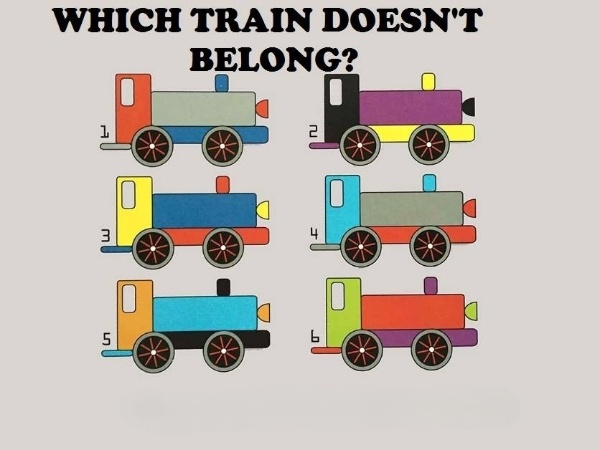Have you ever been faced with a puzzle that seems simple at first glance but proves tricky upon a closer look? Today, we’re tackling just such a puzzle: “Which train doesn’t belong?” This puzzle is more than a question about trains—it’s a challenge to your observation and logic skills. Let’s break down how to solve this puzzle and explore why it’s easy to make mistakes when trying to find the answer.

Common Mistakes When Solving Visual Puzzles
One of the most common mistakes when approaching visual puzzles is rushing to a conclusion without carefully analyzing each detail. Visual puzzles like this one rely on small but significant differences, such as color, shape, size, and orientation. Overlooking these subtle details can lead to incorrect conclusions, which is why it’s crucial to take a methodical approach. By slowing down and analyzing each element carefully, you can spot the patterns and find the correct answer.
Step-by-Step Analysis: Identifying Which Train Doesn’t Belong
Let’s break down the “Which train doesn’t belong?” puzzle step by step, examining the image of six different trains, each with unique colors and designs.
1. Observation
The first step is to closely observe each train. Take note of the colors, number of wheels, overall design, and any other distinctive features. Are there similarities or differences among the trains? Pay attention to things like whether the trains have the same shape, if their cabins are positioned the same way, or if any colors seem out of place.
2. Identifying Patterns
Once you’ve observed the trains, it’s time to look for patterns. In most visual puzzles, there’s a common theme that connects most of the items, and one outlier that doesn’t fit the pattern. Do the trains share a specific color scheme? Is there a recurring design element among most of them?
3. Spotting the Odd One Out
Here’s where things get interesting. In the image, the trains all appear to have similar shapes and the same number of wheels, but one crucial element sets one train apart: the color of the cabin. Trains 1, 2, 3, 5, and 6 all have cabins that match the main color of their engines, creating a cohesive look. However, Train 4 stands out because its cabin is black, while its main body is a different color. This color mismatch makes Train 4 stand out as the odd one.
4. Confirming the Exception
To make sure you’ve found the right answer, double-check that Train 4 is the only one that breaks the color pattern. All the other trains maintain a uniform color scheme between the cabin and body, confirming that Train 4 is the outlier. This confirmation ensures that you’ve solved the puzzle correctly and haven’t overlooked any other differences.
Why Train 4 Doesn’t Belong
Train 4 doesn’t belong because it breaks the established color pattern seen in the other trains. While the rest of the trains have matching colors between the cabin and the main body, Train 4 has a black cabin that contrasts with the color of its body. This mismatch is what sets it apart from the others, making it the correct answer to the puzzle.
Why People Get This Puzzle Wrong
Puzzles like this one are tricky because they play on our natural tendency to overlook small details. Most people are quick to make assumptions and focus on larger patterns, like the shape of the trains or the number of wheels, without digging deeper into more subtle differences like color schemes. It’s easy to get distracted by the obvious elements, which is why this puzzle requires careful observation and attention to detail.
The Importance of Attention to Detail in Puzzles
This puzzle is a great example of how paying attention to the finer details can lead you to the correct answer. Whether it’s a color mismatch, an unusual shape, or a misplaced object, visual puzzles teach us to be more mindful of the small things we often overlook in everyday life. They challenge us to think critically and observe the world more closely.
How Did You Do?
Now that you know the answer, how did you do? Did you spot the color mismatch right away, or were you thrown off by other features? Don’t worry if you didn’t get it right the first time—puzzles like this are meant to challenge your thinking and help you improve your problem-solving skills.
Feel free to share your initial thoughts in the comments below. Did you consider other possibilities before realizing the color difference was the key to solving the puzzle? Were there any other features that stood out to you?


